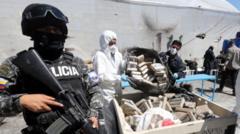**Mexico's attorney general details the connection between the Sinaloa Cartel's power struggles and the killing of journalist Javier Valdez, who reported on organized crime.**
**Mexico Seeks Extradition of Suspected Mastermind Behind Journalist's Murder**

**Mexico Seeks Extradition of Suspected Mastermind Behind Journalist's Murder**
**Calls for the handover of Damaso Lopez Serrano intensify as investigation into Javier Valdez's assassination progresses.**
Mexico's government has formally requested the extradition of Damaso Lopez Serrano, a significant figure within the Sinaloa Cartel, in connection with the 2017 assassination of celebrated journalist Javier Valdez. Valdez, who garnered accolades for his in-depth reporting on drug trafficking, was murdered in Culiacan, where cartel dynamics were under his scrutiny. Mexican officials assert that Serrano, known as “Mini Lic,” orchestrated the killing due to Valdez's critical coverage of cartel infighting that followed the arrest of Joaquin "El Chapo" Guzman.
Following his arrest on fentanyl-related charges in Virginia on December 13, U.S. authorities were approached for extradition. During a press briefing, Mexican Attorney General Alejandro Gertz labeled Serrano as the "mastermind" behind Valdez’s murder, highlighting that his extradition attempts have historically been met with denials as U.S. officials regarded him as a "protected witness" providing crucial information.
Valdez’s relationship with Serrano soured after the journalist portrayed him unfavorably in his writings, encapsulating Serrano as ineffectual despite his lofty position. Following Guzman's arrest, a violent internal struggle ensued within the Sinaloa Cartel, leading to a series of power grabs and retaliatory violence that marked the turbulent period. Investigative records denote that, while Serrano surrendered to U.S. law enforcement in 2017 to face drug charges, he continued his controversial alliance with authorities.
Despite these entangled pathways to transparency, the murder of journalists in Mexico persists as an alarming trend. The nation's reputation as one of the deadliest for media professionals is underscored by the grim statistics provided by Reporters Without Borders, indicating over 150 journalist fatalities since 1994, with 2022 among the deadliest years recorded. Recent incidents, including the killings of two reporters in an ongoing climate of violence, reinforce the urgent call for accountability and protection for journalists in the country.
Following his arrest on fentanyl-related charges in Virginia on December 13, U.S. authorities were approached for extradition. During a press briefing, Mexican Attorney General Alejandro Gertz labeled Serrano as the "mastermind" behind Valdez’s murder, highlighting that his extradition attempts have historically been met with denials as U.S. officials regarded him as a "protected witness" providing crucial information.
Valdez’s relationship with Serrano soured after the journalist portrayed him unfavorably in his writings, encapsulating Serrano as ineffectual despite his lofty position. Following Guzman's arrest, a violent internal struggle ensued within the Sinaloa Cartel, leading to a series of power grabs and retaliatory violence that marked the turbulent period. Investigative records denote that, while Serrano surrendered to U.S. law enforcement in 2017 to face drug charges, he continued his controversial alliance with authorities.
Despite these entangled pathways to transparency, the murder of journalists in Mexico persists as an alarming trend. The nation's reputation as one of the deadliest for media professionals is underscored by the grim statistics provided by Reporters Without Borders, indicating over 150 journalist fatalities since 1994, with 2022 among the deadliest years recorded. Recent incidents, including the killings of two reporters in an ongoing climate of violence, reinforce the urgent call for accountability and protection for journalists in the country.


















